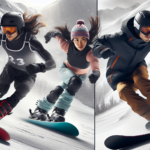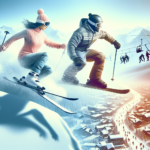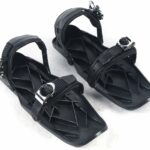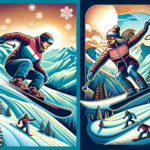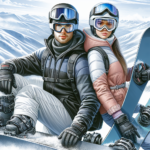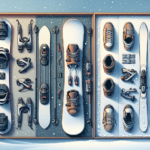So, you’re finally headed to the slopes but can’t quite decide between skiing or snowboarding? This article is here to help! You’ll get a rapid-fire comparison between the two frosty sports highlighting factors like ease of learning, physical demands, equipment costs, and even the culture of each, so you can make a confidently informed decision. Let’s get to it, “Should You Ski Or Snowboard?”
Understanding the Differences: Skiing vs. Snowboarding
Whether you’ve never stepped foot on a snow-covered slope or you’re a seasoned mountain lover looking to switch things up, when it comes to winter sports, you’ve basically got two choices: skiing or snowboarding. But which one should you go for? To make your decision, you need to understand the key differences between these two sports.
Key differences between skiing and snowboarding
Skiing and snowboarding are inherently different in their core elements. While skiing involves two separate skis and poles for each hand, snowboarding uses a single board and no poles. Skiers embrace a forward-facing position, moving down the slope with one ski on each foot. Conversely, snowboarders approach the mountain differently with their feet positioned sideways on a single board, giving them a different balance and body movement compared to skiing.
Functionality of skiing compared to snowboarding
Skiing is seen as more functional and easier to manoeuvre, especially when moving across flat surfaces or making sharp turns. The dual ski design offers better stability and control when going downhill at high speeds. On the other hand, snowboarding offers a smoother and more fluid ride, similar to surfing or skateboarding. Navigating on a snowboard can be trickier, especially when traversing flat or steep surfaces due to the sideways stance.
Learning Curve: Skiing vs. Snowboarding
Both skiing and snowboarding possess their own unique learning curves, and beginners will face different sets of challenges in mastering these sports.
Initial challenges in learning to ski
It can be awkward to handle two skis and poles initially, and the forward-facing stance may feel unnatural. Mastering turning and controlling speed can also take several tries. However, most beginners find it easier to make progress in skiing after their first few days on the slopes, especially when it comes to mobility on flat surfaces and getting on and off the lift.
Common difficulties in learning to snowboard
Learning to snowboard can be tougher at the beginning. The sideways stance is a lot different than the natural walking position, and it might take some time for beginners to find their balance. Falling is a common occurrence in the early stages as balance, linking turns and changing edges can be tricky to learn.
Progression rates for beginners in both sports
Generally, beginners grasp the basics of skiing quicker than snowboarding. However, once the initial hurdles are overcome in snowboarding, progression to more intermediate and advanced techniques can be quicker when compared to skiing.
Equipment and Gear
The necessary gear for skiing and snowboarding differ, not just in terms of the boarding equipment but also protective gear, boots, and clothing.
Ski equipment essentials
Skiing requires skis, ski boots, poles, helmet, goggles, and appropriate clothing that allows for a range of movement while also being warm and waterproof. Optional equipment includes gloves, sunglasses and ski-specific socks.
Must-have snowboarding gear
For snowboarding, a snowboard and snowboarding boots are the primary equipment required. Just like skiing, a helmet, goggles and appropriate clothing are essential. There are no poles needed in snowboarding, but protective padding, especially for your backside, can be beneficial for beginners.
Cost comparison between ski and snowboard gear
When it comes to buying or renting gear, costs can vary widely based on brands, quality, and where you are shopping. Generally speaking, basic snowboarding equipment tends to be slightly cheaper than skiing gear.
Safety Considerations
Snow sports come with their risks, and responsible boarding calls for a mindful approach to safety.
Injury rates in skiing
Though skiing might initially be easier to pick up, this doesn’t mean it’s without its risks. Knee injuries are common in skiing with twisting falls causing ligament tears. Other potential dangers include thumb sprains and head injuries.
Common snowboarding hazards
On the other hand, snowboarding is associated more with upper body injuries. As a newbie, you’ll spend considerable time falling backwards or forwards as you find your balance, leading to potential wrist, shoulder, and head injuries.
Protective gear recommendations for both sports
Regardless of your sport of choice, helmets are non-negotiable. You could also consider wrist guards for snowboarding and knee braces for skiing. Opt for gear that fits well and is designed specifically for the demands of these sports.
Physical Fitness Requirements
Both skiing and snowboarding require different types of physical strength and endurance.
Muscle groups used in skiing
Skiing requires good leg strength, specifically in your quads, hamstrings, and calves. It also demands core stability and good balance. Your upper body and arm strength play a crucial role in propelling yourself with poles and getting up after a fall.
Physical demands of snowboarding
Snowboarding engages your ankles and calves predominantly because of the board’s responsive dynamics. Your core strength is vital to maintain balance and control on your snowboard, while upper body strength will come in handy when you have to push yourself up from the snow.
Ideal fitness levels for both sports
Although anyone can enjoy skiing and snowboarding, being in good physical shape will enhance your performance and enjoyment. Regular cardio, strength training, and balance exercises will serve to prep your body for the demands of these snow sports.
Best Locations for Each Sport: Skiing vs. Snowboarding
The best spots for snowboarding and skiing can vary, depending on your skill level, preferred terrain, and local weather conditions.
Top ski destinations worldwide
World-class skiing destinations include the French, Swiss, and Austrian Alps, the Canadian Rockies, and the Colorado mountains. Each of these locations offers a range of slopes for beginners to pros, along with stunning winter landscapes and ski resort facilities.
Best snowboarding spots
Great snowboarding spots cater to boarders’ love for diverse terrain with half-pipes, rails, and ramps. Again, places like Canada, the US, and Europe dominate the list, but Japan also offers excellent locations for snowboarding with its deep snow and long seasons.
Locations suitable for both skiing and snowboarding
Most resorts and snow-covered mountains can accommodate both skiers and snowboarders. As both sports have grown in popularity, many places offer varied terrain and park features that can be enjoyed irrespective of whether you’re on skis or a snowboard.
Similarities Between Skiing and Snowboarding
Despite their differences, skiing and snowboarding share some similarities that translate from one sport to another.
Both sports require a good sense of balance, a level of physical fitness, and an ability to judge and adapt to different terrains and conditions. Whether you’re standing on one board or two skis, the joy of executing a perfect slide down a slope knows no discrimination.
Common elements in ski and snowboard culture
The community culture of skiing and snowboarding is very similar. Both sports place a strong emphasis on enjoying the outdoors, personal progress, and camaraderie. A day on the slopes often ends with shared tales of triumphs (and occasionally spills) over apres-ski drinks and food.
Overlapping equipment and clothing
The clothing, goggles, helmets, and protective gear used for skiing and snowboarding are virtually interchangeable. Each sport also necessitates waterproof, breathable clothing, and layers to adapt to changing conditions on the mountain.
Unique Aspects of Each Sport
While skiing and snowboarding share some similarities, each sport offers a unique experience and its own set of challenges.
Unique challenges in skiing
Skiing demands coordination between four separate pieces (two skis and two poles), instead of just focusing on one board. Maintaining control over the separately moving skis can present a challenge, as can learning to navigate with poles.
Distinguishing features of snowboarding
Snowboarding necessitates a new way of thinking about navigation since you’re transitioning from a forward-facing stance to a sideways-facing stance. This difference influences how you approach turns, speed, and maneuvers. Also, the snowboarding culture is strongly influenced by skateboarding and surfing, bringing its own style and flair.
How each sport provides a different experience on the slope
Skiing offers a highly controlled and stable ride with the freedom to cover more varied terrain quickly and easily, while snowboarding offers a more laid back and freestyle approach, akin to surfing on the snow.
Transitioning From Skiing to Snowboarding or Vice Versa
There’s good news if you’re already a proficient skier or snowboarder and fancy switching sports – some skills and knowledge transfer pretty well from one to the other.
Tacit knowledge from skiing that will help in learning snowboarding
If you’re already a skier, you’ve already developed a sense of balance and movement on snow, which will provide a strong foundation for learning to snowboard. Understanding how snow conditions can affect your ride and having experience using chair lifts can also simplify the learning process.
How snowboarding knowledge can smooth the learning curve when transitioning to skiing
Already comfortable on a snowboard? Your developed sense of balance and familiarity with navigating down slopes can benefit your skiing lessons.
Which Sport is Right for You?
There’s no definitive answer to the ski vs. snowboard question – it all depends on your individual preferences, expectations, and physical capabilities.
The influence of personal preference and physical ability
Your physical condition, flexibility, and current fitness level will influence how quickly you pick up skiing or snowboarding. Not to forget, your enjoyment will play a crucial role too – you are more likely to excel at a sport you love.
Making the decision: considering factors such as safety, learning curve, and enjoyment
When deciding whether to ski or snowboard, consider which learning curve you feel more comfortable tackling, which type of gear you prefer, the safety concerns of each sport, and most importantly, which one seems the most fun. After all, what really matters is enjoying the exhilarating experience of zipping down the slopes, surrounded by stunning winter landscapes, regardless of whether you’re strapped into a pair of skis or a snowboard.
- What Snowboard Bindings Should I Get? - January 23, 2024
- What Size Screws For Snowboard Bindings? - January 23, 2024
- How To Snowmobile On Water? - January 23, 2024



